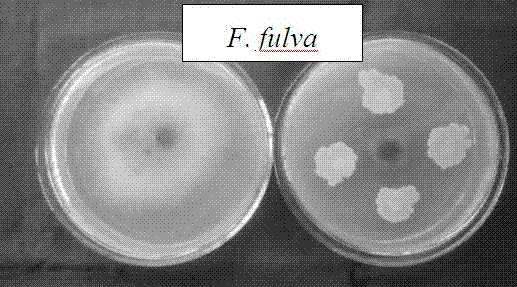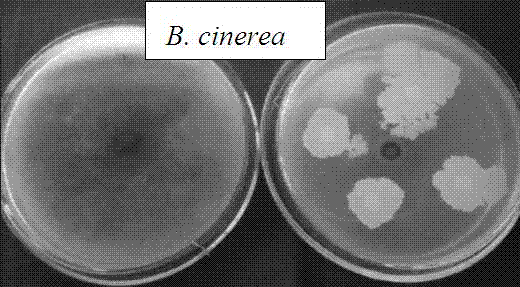Bacillus subtilis BBD012 and application to prevent and treat tomato disease
A technology of Bacillus subtilis and BBD012, which is applied in the field of microorganisms, can solve the problems of decreased control effect of chemical agents, endangering human and animal health, and pollution of agricultural products and the environment by chemical agents.
- Summary
- Abstract
- Description
- Claims
- Application Information
AI Technical Summary
Problems solved by technology
Method used
Image
Examples
Embodiment 1
[0020] Potted tomato control using preparations to prevent tomato gray mold:
[0021] Step 1. Inoculate a single colony of Bacillus subtilis BBD012 in 200mL LB liquid medium, in a constant temperature shaking incubator at 28°C for 160r.min -1 Cultivate for 24 hours, and dilute the cultured bacterial solution to 4×10 8 cfu.mL – 1 , preparing a preparation for preventing tomato gray mold;
[0022] Step 2: Take potted tomatoes that grow to 5-6 leaves and have the same growth, spray the front and back of the tomato leaves with the preparation for treating and preventing tomato gray mold, and use clean water as a control. After 24 hours, the spore suspension of tomato gray mold 1×10 7 spores / mL (Pour a little sterile water into the PDA plate covered with Botrytis cinerea, scrape off the spores on the surface of the agar, pour them into a sterile container, shake them fully, filter them with sterile gauze, and count them on the blood cell plate) spray inoculated on it. Tomato p...
Embodiment 2
[0028] Potted tomato control with preparations for the prevention of tomato leaf mold:
[0029] Step 1. Inoculate a single colony of Bacillus subtilis BBD012 in 200mL LB liquid medium, in a constant temperature shaking incubator at 28°C for 160r.min -1 Cultivate for 24 hours, and dilute the cultured bacterial solution to 4×10 8 cfu.mL – 1 , preparing a preparation for preventing tomato gray mold;
[0030] Step 2: Take potted tomatoes that grow to 5-6 leaves and have the same growth, spray the front and back of the tomato leaves with the preparation for treating and preventing tomato gray mold, and use clean water as a control. After 24 hours, the spore suspension of tomato gray mold 1×10 7 spores / mL (Pour a little sterile water into the PDA plate covered with Botrytis cinerea, scrape off the spores on the surface of the agar, pour them into a sterile container, shake them fully, filter them with sterile gauze, and count them on the blood cell plate count) spray inoculated ...
Embodiment 3
[0036] Screening, isolation and purification of Bacillus subtilis BBD012 strain:
[0037] Step 1, preparation of culture medium:
[0038] LB medium for bacterial plate culture (tryptone 10g / L; yeast extract 5g / L; sodium chloride 10g / L; agar powder 18g / L), LB liquid medium for liquid culture (without adding agar powder), fungi PDA medium (potato 200g / L; glucose 20g / L; agar powder 18g / L) was used for culture and plate confrontation test.
[0039] Step 2: Collect 3g leaves of healthy white lentil plants, soak them in 75% alcohol for 30s, then sterilize them with 1% sodium hypochlorite for 3 minutes, rinse them with sterile distilled water for 5 times, take the last rinse solution 200μL and spread it on LB On the culture medium plate; the sterilized leaves were ground in a sterile mortar, mixed with 5ml of sterile distilled water, and 200 μL of the grinding liquid was taken and spread on the LB medium plate. Cultivate at 28°C and observe day by day. If there is no colony in the ...
PUM
 Login to View More
Login to View More Abstract
Description
Claims
Application Information
 Login to View More
Login to View More - Generate Ideas
- Intellectual Property
- Life Sciences
- Materials
- Tech Scout
- Unparalleled Data Quality
- Higher Quality Content
- 60% Fewer Hallucinations
Browse by: Latest US Patents, China's latest patents, Technical Efficacy Thesaurus, Application Domain, Technology Topic, Popular Technical Reports.
© 2025 PatSnap. All rights reserved.Legal|Privacy policy|Modern Slavery Act Transparency Statement|Sitemap|About US| Contact US: help@patsnap.com



